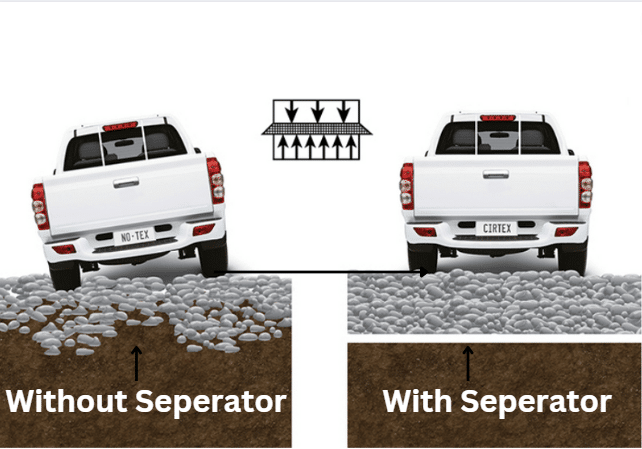GEOGRID, GEOTEXTILE, OR BOTH?
Which product is the greatest choice for various scenarios when it comes to base stabilization and strengthening of roadways, foundations, and working platforms?
The most typical application is to install a polypropylene geogrid first, then a non-woven needle-punched geotextile directly on the subgrade. The use of woven geotextiles alone is an additional alternative, as are occasionally composite products that combine one or more of the aforementioned.
I'll outline the purposes and advantages of geosynthetics in this piece, then make it clear which products can fulfill these purposes to make your choice process easier.
THE GEOSYNTHETICS BENEFITS FOR BASE STABILISATION
Because geosynthetic stabilization is an expensive option, we require (or rather, expect) the product to provide a considerable benefit. In this application, we would be using the geosynthetic to either improve the constructability of the site, which is providing a base for the construction equipment to access the site to begin permanent works, or to reduce the thickness of aggregate required for the same load bearing or heavy vehicle axle pass capacity.
The significant environmental benefit is another advantage that has frequently been disregarded. Incorporating a stabilization or reinforcing layer to lessen the amount of crushed rock on a project site conserves both the greenhouse gases produced during the quarrying, crushing, and carting processes as well as a considerable amount of quarried resource in terms of cubic meters of stone.
INNOVATIVE AND COMPOSITE PRODUCT DEVELOPMENT
The goods of choice have frequently been a nonwoven geotextile followed by the geogrid, which is a great and tried-and-true technique, as we indicated before. But recently, single-layer products with claims to perform three, four, or even five tasks in one have become more prevalent. Examples include composites of geotextile and geogrid and even woven fabrics. Even if some of these are very amazing products, I believe that in order to fully comprehend these things, we need to take a step back and examine the functions that are involved.
You should be knowledgeable about the tools you use as a professional and not just rely on an emblem or a claim on a marketing brochure.
A SHORT DESCRIPTION OF HOW GEOSYSTEMICS WORKS
In this article, we'll go into greater detail about the five main roles that a geotextile or geogrid plays in road and foundation applications: separation, stabilization, filtration, drainage, and reinforcing.
SEPARATION
In order to prevent mixing, a geosynthetic material is placed between two geotechnical materials that are different from one another. Simply put, it prevents the more expensive and higher quality imported aggregate from blending with the subgrade and losing strength. The foundation courses can be separated from the subgrade courses using woven and nonwoven fabrics.
STABILISATION
The action of the geogrid and aggregate working together to create a composite mass with a higher modulus or stiffness than unreinforced granular material is referred to as this function, which is relevant to pavements and foundations. This function is frequently described using the phrases aggregate interlock and lateral restraint. While stabilization demands stiffness at low strain, significant ultimate strength is not necessary.
FILTRATION
The geosynthetics work through filtration to keep upstream soil particles in place while allowing water to permeate the soil. This is crucial in areas with underground water because dynamic loads' pumping action or the varying levels of the water table can cause fines to move from the subgrade into the base course.
DRAINAGE
Within the geosynthetic structure's plane, drainage occurs when the geosynthetic works as a drain to transport fluid flows through less permeable soils. This is most frequently used in subsurface drains for roadways and retaining wall drainage applications.
EITHER ONE OR TWO FUNCTIONS
Also Read: 5 Ways To Stay Safe While Working At Great Heights
I won't get into the argument about which functions are the most crucial and which ones we should be employed that is now raging among some of the major industry players. But with a firm understanding of the aforementioned, we may construct some precise rules.
Evidently, each of the aforementioned factors has some effect on how well a road base or foundation performs. The main concern I have is when, in an effort to cram too much into one product, we actually compromise each function. For instance, are we decreasing interlock and stabilization if we have a fabric that can efficiently drain water from its plane? Can we anticipate that our road underdrain will be a geogrid with outstanding stabilization and interlocking characteristics?
I now have a firm belief in composite materials. Some of them function exceptionally well and significantly increase the advantages of geosynthetics in engineering. I'm persuaded that in order to apply a product to an issue and find a solution, we need to better understand what we are using and why we are using it.
RECOMMENDATIONS FOR WHAT TO USE
In conclusion, we have had great success with combination solutions that perform two or three tasks simultaneously. With only one application, certain solutions, like GridTex, can provide reinforcement, stabilization, and filtration without sacrificing performance. Contrarily, it has been demonstrated that combining the items can actually improve performance. However, if you need more than three functionalities from a single product, I would carefully consider your goals to make sure you are not making a concession.
For guidance on what geosynthetics might be best for your site, contact us here.

